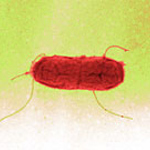Salmonella and their importance as pathogens

Salmonella are gram-negative, straight, rod-shaped bacteria (Fig. 1 left, electron microscopic depiction of a Salmonella cell with flagella, fimbria and pili; the line represents one-thousandth of a millimetre). The flagella arranged around the outer shell make lively movements possible. Furthermore, they can carry fimbria. They facilitate adhesion to the intestinal wall of the host. Some strains also have so-called pili. They transmit genetic material (DNA) in resistant strains.
Biochemical and serological tests can be used to distinguish between the two species Salmonella enterica (S. enterica) and Salmonella bongori (S.bongori). S. enterica has six sub-species. Salmonella isolates can be assigned to one of more than 2,400 serovars (strains with the same antigens) according to the Kauffmann-White method using "slide agglutination" (Fig. 2 right, slide agglutination of Salmonella; antiserum is mixed with a bacterial suspension on a slide. On the left positive reaction (bacteria clumping), on the right negative reaction (homogeneous turbidity).
Compared with other bacteria the growth needs of Salmonella are modest. They grow on simple nutrient media and the optimum temperature is 37°C. In order to improve diagnosis a series of special nutrient media was developed for Salmonella, which exploit and display specific biochemical properties of Salmonella. After only 18 to 24 hours incubation typical, 1-2 mm sized, round, slightly domed, shining colonies already become visible.
Importance of Salmonella as pathogens
Bacteria of the Salmonella genus are widespread in nature. They can be detected in many cold and warm-blooded animals across the globe. In numerous countries today they are the most important bacterial diarrhoea-causing pathogens in man. As they are mostly transmitted from animals to man through consumption of foods of animal origin, salmonellae are classified as zoonoses ("zoonosis" is the scientific term for all diseases which can be transmitted by pathogens from animals to man).
In Germany salmonellosis occurs endemically and, aside from acute respiratory disorders, it is one of the most common infectious diseases. The proportion of reported cases of the disease is, however, estimated to be only 10 to 20% of the actual cases. In recent years 90% of foodborne infections could be traced back to Salmonella. The spread of Salmonella is encouraged by inadequate cooling of foods. Hence, particularly in summer, the infection dose of approximately 1,000 up to 10,000 pathogens (absolute number) can be quickly reached through rapid multiplication of the bacteria in food. The infection dose indicates from what number of ingested pathogens the onset of the disease is possible. If only a few pathogens are ingested, the immune system is normally able to destroy the germs without manifesting any symptoms of disease. The type of animal husbandry, slaughter and marketing also influence the incidence of Salmonella. The globalisation of trade and tourism contribute to its spread as well. The ready adaptability of Salmonella to various milieu conditions, its resistance to harmful influences and the high multiplication rate have contributed overall to Salmonella diseases topping the list of foodborne diseases.
Most of the 2,400 serovars can be found in humans and all species of animals. Some serovars like Salmonella typhi (S. Typhi, the pathogen of typhoid), Salmonella paratyphi (S. Paratyphi, the pathogen of paratyphoid), as well as S. Gallinarum and S. Dublin are host-specific and mostly only found in humans, chickens and cattle.
Depending on the infection dose and the clinical picture, Salmonella cases in humans normally follow one of two courses:
The typhoid form (typhoid-like diseases) is mainly triggered by the serovars S. Typhi, S. paratyphi A, B and C. The disease can be transmitted from man to man. The pathogens are ingested orally and transmitted via blood. The infection dose is low (102 - 103 cfu/ml) (colony-forming units). After a short incubation period (a few days up to 3 weeks) severe, cyclic general infection occurs accompanied by diarrhoea, high temperature and possible damage to the intestines, heart, liver, kidneys and gallbladder. Particularly in the case of patients with gallstones, the pathogens may be excreted over long periods.
Most of the other Salmonella serovars trigger the so-called enteritic course of the disease in humans (enteritis = "intestinal inflammation"). Depending on the health condition of the persons affected, the minimum infection dose is considerably higher (106 cfu/ml), the incubation period until the manifestation of the disease symptoms is shorter (1-3, possibly 5 days). Inflammation of the intestinal mucosa leads to diarrhoea, sometimes a moderately high temperature; however there may be no manifestation of symptoms of the disease. In animals infection with these pathogens frequently occurs without any symptoms. Ongoing excretion over a period of many years is possible.
Given the high number of cases of diseases in humans, salmonellosis is one of the most important, reportable diseases. Typing by means of special phages and molecular-biological methods and the determination of resistances to antibiotics play an important role in the elucidation of epidemiological questions.
